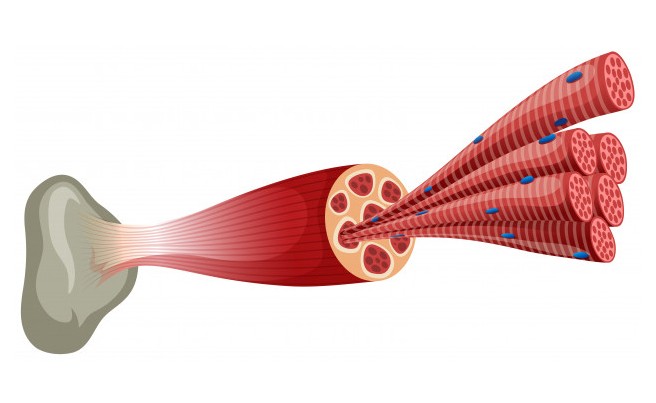Resources
Useful articles

Whether you’re considering starting a fitness program or you’re deep into one and you’ve hit a plateau, sooner or later you’ll be stuck with one pressing, powerful question: how long? How long does it take to build the muscle you’re looking for?
Obviously, building muscle doesn’t happen overnight. At the same time, though, if you’ve been working out for weeks and you aren’t seeing any tangible growth, you’re going to lose your motivation. It’s hard enough to build and stick with the habit of working out, but when you aren’t even seeing results, why bother?
How Muscle Growth Works
First, in order to know how long it takes muscles to grow, you need to know how that growth process works in the first place. It’s entirely possible that you’re seeing muscle growth, but you aren’t recognizing it for what it is.
To put it in simple terms, muscles grow when they heal after being damaged. It’s a specific kind of damage, though; tripping and falling doesn’t buff up the muscles you land on, after all.
When you work out, lifting weights or jogging or whatever else you do, you damage the muscles you use. This damage happens through regular use, but only when you’re pushing yourself; running faster, lifting more, and so on. This stretches and tears the muscle fibers and releases hormones into the bloodstream.

The hormones do a lot throughout your body. Among other things, they stimulate your body to process proteins, activate stem cells near the damaged muscles, stimulate the production of anabolic hormones, and start the healing process. When muscles heal, the fibers fuse together and grow, which increases both their size and their strength. They become more resistant to damage, allowing you to do more with them before they are damaged again, repeating the process.
Technically, this process starts happening immediately upon damaging those muscles from working out, though the healing may take a day or two to process. So why don’t you see muscle growth in a day or two after working out?
Well, the truth is, it’s because of the scale of damage we’re talking about. Muscle damage from working out happens on a microscopic level. Muscle fibers aren’t much larger than the size of a human hair; the damage and bulking cycle is still near-microscopic levels of growth. This is why strength and muscle growth training is an ongoing process, not something you do for a few weeks and stop, goals attained.
You also have to contend with transitory hypertrophy, or “the pump” as many bodybuilders call it. When you lift, your muscles get flooded with blood, bulking them up temporarily. This helps protect them, increase their strength, and stimulate healing immediately. It also makes them look larger and fuller. That effect fades, somewhere between a few minutes and a few hours after working out. If you’re used to comparing yourself before and after workouts, you’ll often see what seems like a decrease in muscle mass, when it’s really just the effects of the pump wearing off.
Strength Vs Growth
Early in your weight lifting career, you’ll probably notice three things:
- Your body fat begins to decrease
- Your strength begins to increase
- Your muscle mass does not change
The reason for this is that your early strength gains in weight lifting are not actually due to bulking up the muscles themselves. Instead, your body and mind have to adjust to actually using muscles you haven’t been using before. Your body is learning how to control those muscles and get as much strength out of them as it can before it starts to push them beyond those limits.

This is why, early in your career, you’ll see gains in the amount of weight you can lift, but not in the amount of muscle you have, visibly. At the same time, though, you’ll look better, slimmer, and possibly more toned, simply because you’re burning fat. Losing that body fat can help you look like your muscles are growing when they aren’t, quite yet.
In short, you can grow in strength before you grow in muscle mass, and while the lack of visible progress can be disheartening, know that it’s still working, even if it’s not as fast or as obvious as you would like.
Still, though, how long will it really take? The answer depends on a lot of factors. It depends on your testosterone levels, on the intensity of your workouts, on the frequency of those workouts, and even on the plans that you follow.
So, let’s take a look at a few of those plans, biography & workout and see how long they might take.
The 4-Week Workout Plan to Gain 10 Pounds of Muscle from Muscle And Fitness
The first program on our list comes from MuscleAndFitness.com and is a one-month plan to gain ten pounds of muscle. It’s an intermediate skill level workout plan aimed at people who want to train endurance, and who has access and willpower enough to work out four times per week for those four weeks.

The goal of this program is to build up a significant amount of muscle in the form of endurance and mass, not necessarily a focus on strength training. To that end, in addition to the actual exercise plan, the program includes a bulking diet plan that focuses on a balance of macronutrients that give your body the calories it needs to bulk up.
This program won’t let you lose weight; indeed, you’re putting on muscle mass, not shedding water or fat weight.
The first half of the program is all about using high weight, low rep exercises with specific exercises that target multiple muscle groups at once. It’s relatively low volume and is meant to cycle through different muscle groups on different days, allowing those not being actively worked to recover. The recovery is just as important, if not more so than the work itself; it’s what allows the muscle to heal and bulk up, to increase strength and mass. It also helps you avoid injury that would risk setting back your progress.
The second half of the program dials back on the weight a bit and increases reps. This increases the low-level damage to your muscles, and is – according to this site, anyway – the ideal way to promote muscle mass growth.
This is a fairly intense plan, but it proves that you can add a significant amount of muscle in a relatively short time. The risk here is that the workout is too intense as a starter workout, or too light for people who are pushing against plateaus. That’s why it’s labeled intermediate, as much as anything.
The 6 Week Workout Program to Build Muscle from The Bodybuilding Blog
This workout program comes with a PDF guide to take and bring with you. It’s a bit lighter than the 4-week crunch above, without the firm goal of building ten pounds of muscle, and with more flexibility of what you train and when throughout those six weeks. It’s classified as beginner or intermediate, so it’s suitable for newcomers to weightlifting and bodybuilding, while also working for experienced athletes, but not really for high-end training.

This is another program with high weights and low reps, which is something you’re likely to see in a lot of muscle growth programs. Your goal is to efficiently damage your muscle fibers and then help those muscles heal without stressing them too much. Push yourself to the point where you can’t do more reps of your heavier weights, do a drop set if indicated, and rest those muscle groups to allow for growth in mass.
One thing we like about this program is that it’s actually extremely flexible. While the routine is baked into the PDF, there is a whole list of substitute exercises available if you can’t or don’t want to do any specific exercises, due to lack of availability of tools or machines for example.
They also don’t go hard on recommending specific diets or supplements. Eating clean and healthy, eating at or slightly above maintenance level, and making sure you get enough protein is just about it.
The 10 Week Mass Building Program from Muscle and Strength
This program is a longer program from MuscleAndStrength.com, and it’s focused on two and a half weeks of bulk-building working out. It’s a split workout with an advanced training level, working out four days each week for just under an hour each workout.

Unlike the above workouts, which are intermediate level, this is an advanced level workout aimed primarily at athletes and bodybuilders who want to bulk up and push themselves past a plateau. It’s going to be a lot to handle for someone new to the scene.
Again, this program is a high weight and low reps program, meant to push and build muscle mass, with gaps for recovery in different muscle groups. For example, the first day is chest day, the second is back day, and the third is resting and cardio. Keeping up the cardio is important, to keep blood flowing to those muscles and let them heal.
This guide doesn’t mention much about supplements, though it has a few recommendations, largely protein and creatine to help stimulate muscle growth. It also doesn’t mention diet, because it assumes that by the time you’re pursuing a program like this, you’ve gotten your diet in order and are already doing basically the right things.
You can download this workout as a PDF as well if you like, to keep it on hand while you’re on the go, or just print it out to have a physical version to mark up for each week you’re working at it.
The Kick Some Mass 12 Week Mass Building Workout from Muscle and Fitness
Here we return to the same people who developed the four-week program that was first on the list. Interestingly, this is a much more subdued workout plan. Rather than attempting to build extreme mass by putting on ten pounds in four weeks, this program pushes you to build a “mere” four pounds in twelve weeks. It’s almost a reversal of what the previous program asks for.

While we say “subdued”, we don’t mean it’s easy, by any means. This program is an advanced program meant to gain mass and push past plateaus with sustained effort over three straight months of work. In fact, they say that to even start, you should have at most 14% body fat and at minimum 18 months of training experience under your belt. It’s an intense workout, and you’ll see why if you visit the site.
Like their other program, they don’t focus too much on diet and supplements beyond making sure you have the right macros, you’re eating clean, and you’re not eating far too much or too little to bulk up. They have advice and formulas to help, but it’s not a strict diet plan.
One thing we like about this plan is that it starts with some math. If you’re an advanced athlete, you want to take the time to math out what your body needs. Where are you, what are your goals, and how can you use this plan to achieve them? They have advice and formulas to help guide you to this information.
The Butt Bible from Fighter Diet
This is a direct PDF link to a massive ebook. We don’t necessarily endorse this entire book, but it does contain a program for twelve weeks of working out, four times per week, with a lot of detail.

This book is great because it’s long, detailed, and offers a ton of information, perspective, and assistance to help you with the program. The goal of the program isn’t even pure muscle growth, but a combination of toning and growth alongside some weight loss.
We’ve included it primarily to illustrate that there’s a very, very wide range of different kinds of workouts out there, and all of them can work in the right situations. You’re not limited to intense bodybuilding programs, or to fitness regimens, or to composites you make yourself. Somewhere, there’s going to be a program that’s right for you.
So all of this goes to answer one real question: how long does it take to put on muscle?
In the short term, you can build some muscle mass in as little as two weeks, though you aren’t likely to see massive gains without a bunch of auxiliary work. For more reasonable goals, you should set your expectations around three months of work, and go from there. Regardless, though, the combination of diet, exercise, rest, and persistence is the key.
Thank! Your message has been sent successfully.











Questions and answers 0